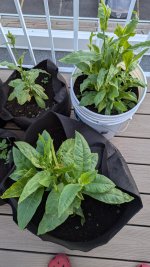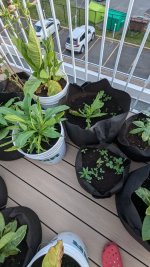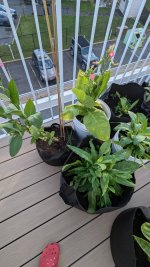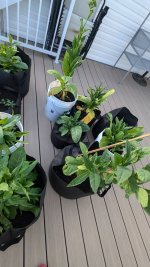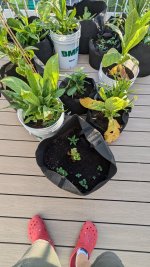Skafidr
Well-Known Member
Not sure how to organize this post, but here goes.
Sooo... I harvested my leaves after the hail shredded them, and I decided to go for a sucker crop (see the post in the blog here). I removed all the stalks and decided to let new suckers grow from the base.
However, a lot of my plants suffered, apparently, from frenching.
After reading around, I decided to buy soil pH test strips to, well, check the pH of the soil. I sampled three of my pots; the results show that the pH is between 6.0 and 6.5. These test strips are not hard to _use_ but are imprecise, you don't get a hard number, you have to interpret the colours on the strip.
So the apparent conclusion here is that the soil is not acid enough.
I'm no longer really interested in having a sucker harvest at this point, given how bad the plants look, I'm more interested in the challenge of getting them "back on track".
Now a few random points:
I'm trying to figure out if it's just soil nutrient deficiency (including "high pH"), or if something else caused it, e.g.: I cut the plants -> [the need in water suddenly drops] + [more rain water gets to the pot because the leaves that protected it are no longer there] -> the soil gets too wet -> it gives more ammo to the Bacillus cereus to be active and produce its toxins.
What would be the recommended next steps (a soil test professionally done by a decent organisation is not an option for now ($$$))? Can the "toxins" be washed away (e.g. if I let water go through for some time)? Can I mix some fertilizer with diluted vinegar and feed this to the plants to 1) adjust the pH and 2) make the nutrients readily available for when the "toxins" stop disabling absorption? Should I see if my soil pH tests actually work by taking two samples from the same pot, and add a bit vinegar to one of the samples before doing the test? (In fact, this should likely be done in any case )
)
Thanks!
Sooo... I harvested my leaves after the hail shredded them, and I decided to go for a sucker crop (see the post in the blog here). I removed all the stalks and decided to let new suckers grow from the base.
However, a lot of my plants suffered, apparently, from frenching.
After reading around, I decided to buy soil pH test strips to, well, check the pH of the soil. I sampled three of my pots; the results show that the pH is between 6.0 and 6.5. These test strips are not hard to _use_ but are imprecise, you don't get a hard number, you have to interpret the colours on the strip.
So the apparent conclusion here is that the soil is not acid enough.
I'm no longer really interested in having a sucker harvest at this point, given how bad the plants look, I'm more interested in the challenge of getting them "back on track".
Now a few random points:
- plants seemed okay before the hail (2024-08-14); although some displayed signs of slight downward curling
- I harvested all the leaves at once (2024-08-16)
- I cut the stalks at the base (2024-08-18)
- I gave a shot of fertilizer not so long ago (2024-09-19); the plant had a "boost" in growth but still grew funny, I think
- It's fall here, nights are getting cold but we're not that close to freezing yet so I think there is still some time to figure this out
- Whatever I do this season, I'll still have to make sure my soil is decent for next season
- Given that it is fall, water evaporates much less than what we had during the summer, soil is more wet
- I'm thinking, without having any proof (my brain is just trying to fill gaps), that nutrients may have washed away from the soil during the season (and/or have been absorbed by the plants)
- I'm amazed by the fact that they all started frenching at the same time, although this may have been hidden by the fact that the leaves that were there were "started" correctly, and if I had let suckers grow on them, I would have noticed frenching too; that may not be the case, though because on some picutres, the "bottom" leaves that were there when I cut the stalks seem okay, while what grows after I cut the stalks show frenching
- A sucker harvest may not be "a thing" for the varieties I grew; maybe those varieties are just trash once the main stalk is removed?
I'm trying to figure out if it's just soil nutrient deficiency (including "high pH"), or if something else caused it, e.g.: I cut the plants -> [the need in water suddenly drops] + [more rain water gets to the pot because the leaves that protected it are no longer there] -> the soil gets too wet -> it gives more ammo to the Bacillus cereus to be active and produce its toxins.
What would be the recommended next steps (a soil test professionally done by a decent organisation is not an option for now ($$$))? Can the "toxins" be washed away (e.g. if I let water go through for some time)? Can I mix some fertilizer with diluted vinegar and feed this to the plants to 1) adjust the pH and 2) make the nutrients readily available for when the "toxins" stop disabling absorption? Should I see if my soil pH tests actually work by taking two samples from the same pot, and add a bit vinegar to one of the samples before doing the test? (In fact, this should likely be done in any case
Thanks!


